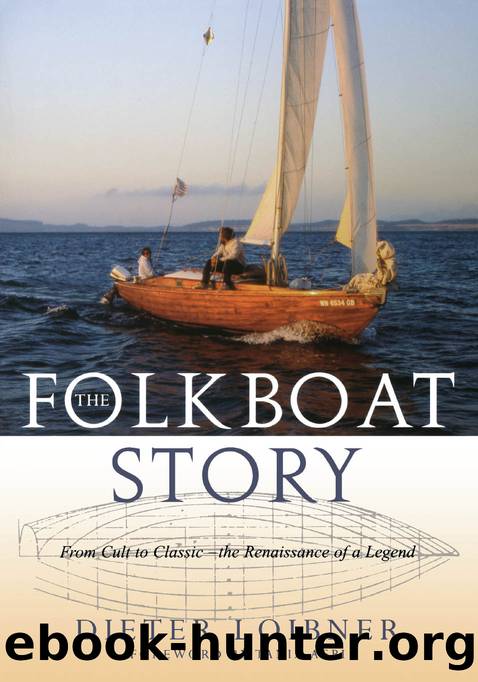Folkboat Story by Loibner Dieter

Author:Loibner, Dieter
Language: eng
Format: epub
Publisher: Sheridan House
Published: 2002-10-15T00:00:00+00:00
United States and San Francisco
If there is a place on earth that seems to be custom-made for the rugged Folkboat it is San Francisco Bay, a body of water notorious for howling winds, rapacious currents and two trillion gallons of sub-60-degree water. The Bay covers a surface of roughly 400 square miles and is framed by a vibrant but overdeveloped urban jungle that has been fueled by economic boom times from the Gold Rush in 1849 to the emergence of Silicon Valley and dot-com mania. Today, more than six million peopleâor the equivalent of a small European countryâare living along the shores of the Bay.
Unlike northern Europe, where good weather and wind often are mutually exclusive, the Bay offers sun and wind in abundance, especially in the summer and after noon when the fog has retreated out to sea. And then there is this vicious current that can make your chest hair stand on ends.
Starboat World Champion, Americaâs Cup participant, car racer and bon vivant Tom Blackaller likened racing in the Bay to bowling. âAs long as you are in the lane it is OK, but once you are in the gutter it gets ugly.â It does not take a lot of fantasy to imagine what is happening here when the westerlies whistle through the Golden Gate with 25-30 knots and clash with a 4.5-knot ebb that is heading the exact opposite way. It is not for the faint of heart, but âa lovely day for a Folkboat,â as Paul Elvström accurately observed.
The first appearance of a Folkboat on San Francisco Bay happened in the mid-1950s. âWe have happily sailed Folkboats on San Francisco Bay since 1955 and informally organized the class in 1956,â wrote Fred Vogelsberg, the first chairman of the San Francisco Bay Folkboat Association to Walter Burnett, who at that time headed the Fleet No. 1 of the United States Folkboat Association, in Detroit, Michigan, which also was formed in 1956.
Vogelsberg expressed pleasant surprise about the existence of a U.S. Folkboat Association as it was listed in the 1958 directory of the North American Yacht Racing Union. âInasmuch as we have not heard of a national organization, quite likely the national organization has not heard from us.â He left no doubt that San Franciscoâs Folkboaters adhered to the Scandinavian school, which mandated a one-design class without spinnakers, heads and other items for creature comfort, although some of the early boats did have an inboard auxiliary engine. He also mentioned Folkboats in Newport, California, where apparently efforts were undertaken to organize existing Folkboat owners into a fleet.
In response to the Californian inquiry, Detroitâs Burnett clarified that âat this time it would be too great an undertaking to organize, maintain and serve as a national Folkboat Association.â Detroitâs Folkboats were mostly of Swedish origin, which the locals liked for their stainless steel rigging, chrome hardware and for the fact that âthey seem to finish ahead of the Danish boats.â Burnett insisted that his constituents all adhere to the Scandinavian
Download
This site does not store any files on its server. We only index and link to content provided by other sites. Please contact the content providers to delete copyright contents if any and email us, we'll remove relevant links or contents immediately.
Whiskies Galore by Ian Buxton(41937)
Introduction to Aircraft Design (Cambridge Aerospace Series) by John P. Fielding(33090)
Small Unmanned Fixed-wing Aircraft Design by Andrew J. Keane Andras Sobester James P. Scanlan & András Sóbester & James P. Scanlan(32763)
Craft Beer for the Homebrewer by Michael Agnew(18194)
Turbulence by E. J. Noyes(7977)
The Complete Stick Figure Physics Tutorials by Allen Sarah(7336)
Kaplan MCAT General Chemistry Review by Kaplan(6899)
The Thirst by Nesbo Jo(6877)
Bad Blood by John Carreyrou(6581)
Modelling of Convective Heat and Mass Transfer in Rotating Flows by Igor V. Shevchuk(6406)
Learning SQL by Alan Beaulieu(6237)
Weapons of Math Destruction by Cathy O'Neil(6213)
Man-made Catastrophes and Risk Information Concealment by Dmitry Chernov & Didier Sornette(5951)
Digital Minimalism by Cal Newport;(5700)
Life 3.0: Being Human in the Age of Artificial Intelligence by Tegmark Max(5509)
iGen by Jean M. Twenge(5384)
Secrets of Antigravity Propulsion: Tesla, UFOs, and Classified Aerospace Technology by Ph.D. Paul A. Laviolette(5332)
Design of Trajectory Optimization Approach for Space Maneuver Vehicle Skip Entry Problems by Runqi Chai & Al Savvaris & Antonios Tsourdos & Senchun Chai(5037)
Pale Blue Dot by Carl Sagan(4950)
